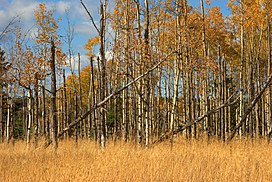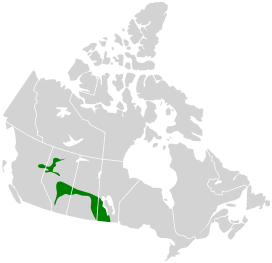| Aspen parkland | |
|---|---|
 | |
 Aspen parkland within Canada | |
| Ecology | |
| Realm | Nearctic |
| Biome | Temperate grasslands, savannas, and shrublands |
| Borders | List
|
| Bird species | 206[1] |
| Mammal species | 72[1] |
| Geography | |
| Area | 397,304 km2 (153,400 sq mi) |
| Countries | |
| States/Provinces | |
| Climate type | Humid continental (Dfb) |
| Conservation | |
| Conservation status | Critical/Endangered[2] |
| Habitat loss | 63.76%[1] |
| Protected | 2.95%[1] |
Aspen parkland refers to a very large area of transitional biome between prairie and boreal forest in two sections, namely the Peace River Country of northwestern Alberta crossing the border into British Columbia, and a much larger area stretching from central Alberta, all across central Saskatchewan to south central Manitoba and continuing into small parts of the US states of Minnesota and North Dakota. [3] Aspen parkland consists of groves of aspen, poplar and spruce, interspersed with areas of prairie grasslands, also intersected by large stream and river valleys lined with aspen-spruce forests and dense shrubbery. This is the largest boreal-grassland transition zone in the world and is a zone of constant competition and tension as prairie and woodlands struggle to overtake each other within the parkland.[4]
This article focuses on this biome in North America. Similar biomes also exist in Russia north of the steppes (forest steppe) and in northern Canada.
- ^ a b c d Hoekstra, J. M.; Molnar, J. L.; Jennings, M.; Revenga, C.; Spalding, M. D.; Boucher, T. M.; Robertson, J. C.; Heibel, T. J.; Ellison, K. (2010). Molnar, J. L. (ed.). The Atlas of Global Conservation: Changes, Challenges, and Opportunits to Make a Difference. University of California Press. ISBN 978-0-520-26256-0.
- ^ Cite error: The named reference
WWFinfowas invoked but never defined (see the help page). - ^ "Tallgrass Aspen Parklands Province".
- ^ Sarah Carter (1999). Aboriginal People and Colonizers of Western Canada to 1900. University of Toronto Press. p. 19. ISBN 0-8020-7995-4. Retrieved 2016-05-14.